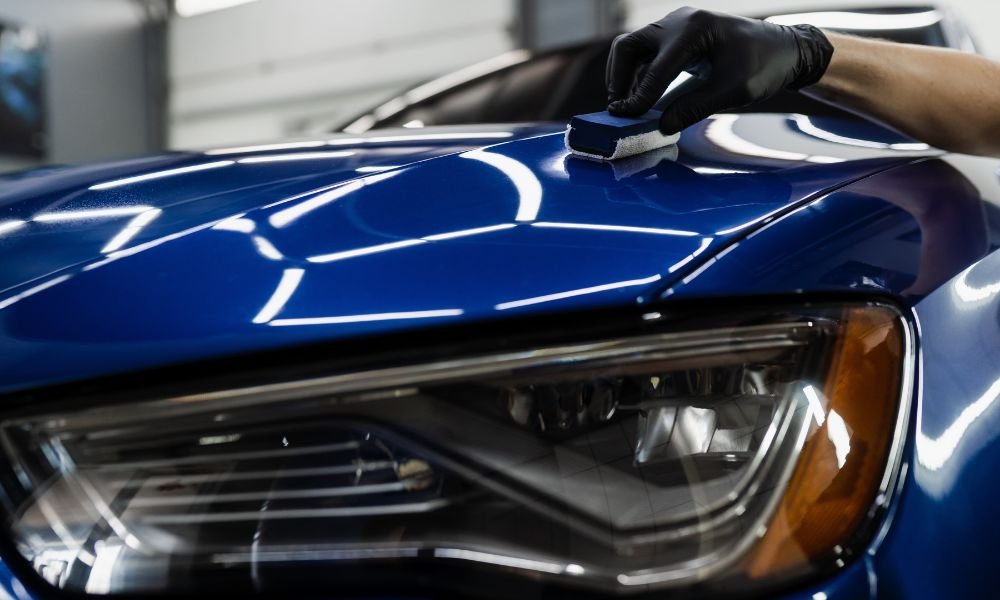Why Ceramic Coating Is the Ultimate Remedy for a Perfect End Up
Ceramic finishing has actually emerged as a leading solution for those seeking a perfect surface for their automobiles, many thanks to its remarkable toughness and safety features. This advanced liquid polymer not just bonds effortlessly with factory paint however additionally supplies a formidable obstacle versus usual hazards such as scratches, UV rays, and environmental contaminants. In addition, its hydrophobic buildings simplify maintenance while improving aesthetic appeal. However, comprehending just how this innovation contrasts to typical techniques and exploring its application subtleties can expose much more concerning its value. What aspects truly set ceramic coating apart?
What Is Ceramic Finish?

When used appropriately, ceramic layer creates a hydrophobic surface area that wards off water and dirt, making it simpler to maintain and cleanse. Unlike traditional waxes or sealants, which generally use short-term defense, ceramic coverings can last for numerous years, relying on the item quality and application method. The procedure of applying ceramic finish requires precise prep work, including detailed cleansing and occasionally repaint modification, to ensure optimal bonding and effectiveness.
Ceramic finishings are not restricted to auto surface areas; they can likewise be utilized on numerous materials, consisting of glass, metal, and plastics, offering a functional service for boosting security. Overall, ceramic covering represents a substantial innovation in surface protection innovation, incorporating both aesthetic and useful benefits for a wide variety of applications.
Benefits of Ceramic Finish
While lots of surface defense options exist, the benefits of ceramic coating stick out because of its unique residential or commercial properties and long-lasting efficiency. One of the primary advantages is its phenomenal longevity. Ceramic Coating Philadelphia. Unlike standard wax or sealants that require regular reapplication, ceramic layers provide a durable layer that can last for several years, substantially lowering upkeep efforts
One more significant advantage is enhanced defense against ecological contaminants. Ceramic finishes create a hydrophobic surface area that drives away water, dirt, and different pollutants, making it easier to clean up. This attribute not only preserves the lorry's appearance but likewise lessens the threat of rust and oxidation, particularly in severe weather condition conditions.
Moreover, ceramic coatings supply premium resistance to UV rays, protecting against fading and degradation of paint with time. This UV defense is critical for maintaining the visual worth of surfaces and vehicles subjected to guide sunlight.
Additionally, the glossy coating achieved with ceramic finish enhances the overall visual allure, giving surface areas a showroom-quality shine. In general, ceramic coverings represent a substantial development in surface area defense innovation, giving enduring benefits that satisfy both visual and useful needs.
How It Works
Recognizing the science behind ceramic layers exposes just how they supply such remarkable protection and durability. At its core, a ceramic finishing is a liquid polymer that chemically bonds with the lorry's factory paint.
The application process includes multiple actions, consisting of surface area preparation, important link which is critical to achieving optimum bond. As soon as used, the finishing goes through a curing process, during which it hardens and forms a semi-permanent bond with the paint surface area. This bond is what differentiates ceramic coatings from typical waxes and sealants, providing a longer-lasting protective obstacle that can endure for years.
Moreover, the thickness of the covering can improve its safety top qualities, making certain that it can endure severe problems. Eventually, the science of ceramic coverings integrates advanced materials with cutting-edge application techniques to deliver an unmatched level of protection and aesthetic enhancement for cars.
Contrast With Standard Techniques
The benefits of ceramic layers become specifically apparent when contrasted to traditional paint security techniques such as waxes and sealants. While waxes offer a short-lived luster, typically lasting a couple of weeks to a number of months, ceramic coverings offer a lasting safety layer that can endure for numerous years. This toughness significantly decreases the regularity of reapplication, making ceramic coatings a more economical option with time.
Furthermore, typical techniques typically call for extensive prep work and numerous applications to accomplish a satisfying degree of defense. On the other hand, ceramic coverings bond at a molecular level with the automobile's surface, developing a durable guard against ecological impurities like UV rays, acid rainfall, and roadway salts. This bond boosts the car's resistance to scrapes and swirl marks, which prevail with conventional waxes and sealants.
Additionally, the hydrophobic residential properties of ceramic coatings drive away water and dust, resulting in much easier cleaning and maintenance. On the other hand, wax and sealant-treated surface areas can draw in grime, demanding more regular cleaning - Ceramic Coating Philadelphia. Overall, read review ceramic coverings not only supply premium defense yet likewise deliver a much more enduring and visually appealing surface, developing them as the favored selection for discerning car proprietors
Application and Upkeep Tips

Utilizing a foam applicator, apply the coating in tiny sections, complying with the manufacturer's standards regarding density and overlap. Permit adequate healing time between coats, generally 24-hour, to guarantee correct bonding. After application, it is essential to avoid direct exposure to water or harsh elements for at least a week to enable the coating to totally cure.
Additionally, using a ceramic upkeep spray can boost the coating's hydrophobic residential or commercial properties and long life. Routine evaluations for any type of indications of wear will certainly help keep the finishing's integrity and protect that excellent surface.
Verdict
In conclusion, ceramic finish arises as a superior alternative for attaining a remarkable vehicle coating. By developing a robust bond with factory paint, ceramic finish successfully shields against scrapes, UV rays, and ecological impurities.
